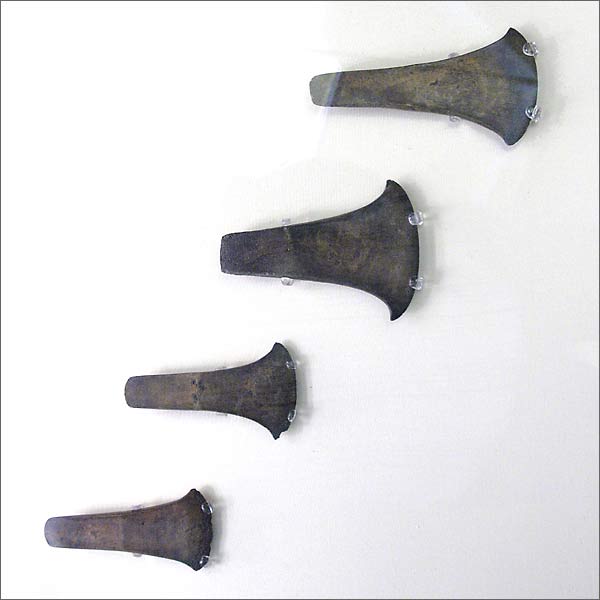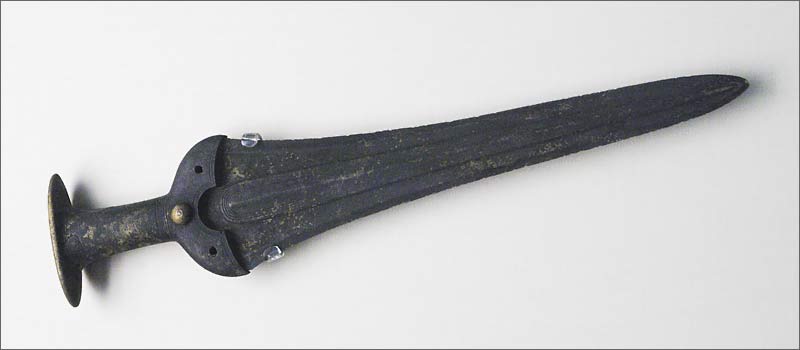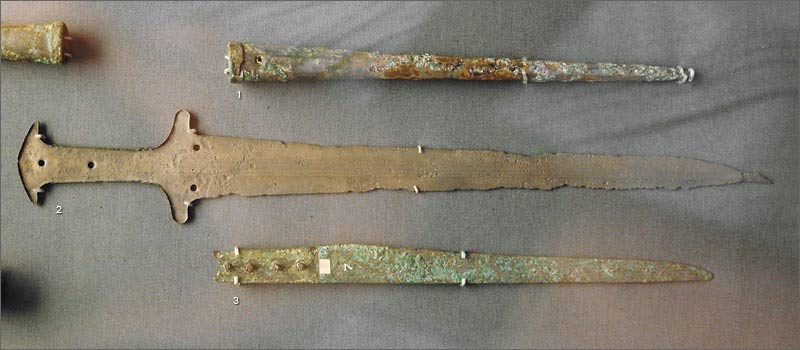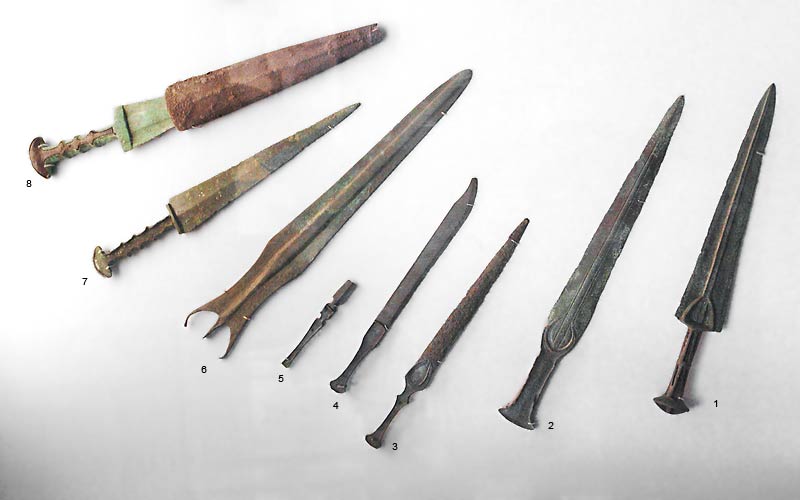| Author |
Message |
Nathan Robinson
myArmoury Admin


|
 Posted: Fri 25 Aug, 2006 2:03 am Post subject: Bronze Weapons from the British Museum Posted: Fri 25 Aug, 2006 2:03 am Post subject: Bronze Weapons from the British Museum |
 |
|
I wanted to share some photos I took at the British Museum a year ago. The descriptions are from the display cards.
Decorated Axes
England, Early Bronze Age, 1900-1700 BC
Found at World Farm, Willerby, North Yorkshire
The axes were described being found lying "together on their side." Three are decorated with patterns that have been punched into the metal. Two of these have simple "rain-pattern" designs, while the third has a more organized arrangement of strokes fringed at the bottom with a zigzag band.

Four Flanged Axes
England, Early Bronze Age, 1700-1500 BC
Found at Arreton Down, Isle of Wight
The bronze hoard found at Arreton in about 1735 was remarkably well recorded. The objects were "...ranged in a regular order, the axes laid on the spearheads..." From this and further finds, it is clear that the place of burial and the careful arrangement of objects were often as imprortant as the objects themselves.

.:. Visit my Collection Gallery :: View my Reading List :: View my Wish List :: See Pages I Like :: Find me on Facebook .:.
|
|
    |
 |
Nathan Robinson
myArmoury Admin


|
 Posted: Fri 25 Aug, 2006 3:42 am Post subject: Posted: Fri 25 Aug, 2006 3:42 am Post subject: |
 |
|
Here is another photo I took at the British Museum a year ago. The description is from the display card.
Decorated Bronze Dagger
England, Early Bronze Age, 1700-1500 BC
Found in the River Thames
Daggers with metal hilts are unusual in Britain and more typical of parts of Europe. This dagger, however, was made in Britain and the pommel shape is typical of daggers at this date. Similar daggers seem to be carved on the Badbury stone.
Daggers and later types of stabbing weapons are often to be found in rivers and bogs in much of western Europe. The ornate dagger from the Thames is an early example of the practice of offering fine weaponry to the water spirits.

Presented by AW Franks
PEE 1882. 5-18. 6
.:. Visit my Collection Gallery :: View my Reading List :: View my Wish List :: See Pages I Like :: Find me on Facebook .:.
|
|
    |
 |
Nathan Robinson
myArmoury Admin


|
|
    |
 |
Greyson Brown

|
 Posted: Fri 25 Aug, 2006 6:01 am Post subject: Posted: Fri 25 Aug, 2006 6:01 am Post subject: |
 |
|
Thanks for sharing, Nathan. I have to ask, though; how do you get such good pictures through glass? I tried to take pictures of some of the same stuff, but I was a lot less successful.
-Grey
"So long as I can keep the path of honor I am well content."
-Sir Arthur Conan Doyle, The White Company
|
|
  |
 |
|
Matthew Amt
|
 Posted: Fri 25 Aug, 2006 7:07 am Post subject: Posted: Fri 25 Aug, 2006 7:07 am Post subject: |
 |
|
Yes, lovely things, thanks for sharing them!
Matthew
|
|
   |
 |
William M

|
|
   |
 |
Nathan Robinson
myArmoury Admin


|
 Posted: Sat 26 Aug, 2006 4:53 am Post subject: Posted: Sat 26 Aug, 2006 4:53 am Post subject: |
 |
|
| Greyson Brown wrote: | | Thanks for sharing, Nathan. I have to ask, though; how do you get such good pictures through glass? I tried to take pictures of some of the same stuff, but I was a lot less successful. |
Combine good equipment with experience and knowledge and one can do the same. I took these photos a year ago and haven't shared them because I am not happy with the results. Thank you for the encouragement.
They're not all like this, as shown below.
.:. Visit my Collection Gallery :: View my Reading List :: View my Wish List :: See Pages I Like :: Find me on Facebook .:.
|
|
    |
 |
Nathan Robinson
myArmoury Admin


|
 Posted: Sat 26 Aug, 2006 1:51 pm Post subject: Posted: Sat 26 Aug, 2006 1:51 pm Post subject: |
 |
|
Another photo I took from the British Museum last year with the text from the accompanying cards:
Mycenaean Weapons
Swords, daggers and spears such as those exhibited here were important weapons to the Mycenaeans. Scenes of combat in Mycenaean art show warriors using them both for warfare and for hunting.

1) Bronze spearhead
Mycenaean, 1400-1300 BC -- Found at Kameiros, Rhodes
This socketed spearhead with a strong mid-rib would originally have been attached to a spear with a long wooden haft.
GR 1861.10-24.27, BM Cat Bronzes 29
2) Bronze sword
Mycenaean, 1300-1100 BC -- Found in Albania
GR 1880.2-28.1, BM Cat Bronzes 2754
3) Bronze sword
Mycenaean, 1400-1100 BC -- Said to be from Corfu
The inherent weakness of this type of sword was the narrow tang, which had a tendency to break, as has happened to this example.
GR 1868.1-10.341, BM Cat Bronzes 2752
4) Bronze sword
Mycenaean, 1450-1300 BC -- Said to be from Mount Olympos in Northern Greece
Swords with a long thin blade and pronounced mid-rib first appeared in Crete late in the 15th century, spread to the mainland, and were popular int he 14th century with the Mycenaeans. They were well-balanced, with an integral hilt and "horns" at the top of the blade to protect the hand of the warrior.
GR 1930.12-15,10
5) Bronze dagger
Mycenaean, 1300-1100 BC -- Probably from Ithaka
The integral hilt and pommel of this dagger made it a very sturdy weapon. The unusual shape of the hilt and down-turned horns of the handgrip probably derive from Near Eastern examples.
GR 1868.1-10.342, BM Cat Bronzes 2753
.:. Visit my Collection Gallery :: View my Reading List :: View my Wish List :: See Pages I Like :: Find me on Facebook .:.
|
|
    |
 |
Nathan Robinson
myArmoury Admin


|
|
    |
 |
Nathan Robinson
myArmoury Admin


|
 Posted: Sat 26 Aug, 2006 2:45 pm Post subject: Posted: Sat 26 Aug, 2006 2:45 pm Post subject: |
 |
|
Another photo I took from the British Museum last year with the text from the accompanying cards:

1) Bronze spear-butt
Mycenaean, 1350-1200 BC
GR 1870.10-8.24, BM Cat Bronzes 22
2) Bronze sword
Mycenaean, 1350-1200 BC
Cruciform sword with a T-shaped flange extension onto which plates of ivory, bone, or wood were once riveted.
GR 1870.10-8.25, BM Cat Bronzes 2
3) Bronze knife with four rivets for the attachment of a handle
Mycenaean, 1350-1200 BC
GR 1870.10-8.27, BM Cat Bronzes 7
.:. Visit my Collection Gallery :: View my Reading List :: View my Wish List :: See Pages I Like :: Find me on Facebook .:.
|
|
    |
 |
Nathan Robinson
myArmoury Admin


|
 Posted: Mon 28 Aug, 2006 1:27 pm Post subject: Posted: Mon 28 Aug, 2006 1:27 pm Post subject: |
 |
|
Another photo I took from the British Museum last year with the text from the accompanying cards:
Iron Age Weapons from western and northwest Iran
Bronze weapons form a major part of ancient metalwork collections from western and northwest Iran. This is because they were frequently placed in graves, as in the excavated cemeteries of Khurvin, Marlik and Tepe Sialk. A wide variety of swords, dirks, and daggers were used in this region during the last centuries of the 2nd millennium and early part of the 1st millennium BC. A selection are displayed here, some of which are paralleled by types used in the southern Caucasus.

1) Bronze dirk typical of NW Iran and the Caucasus
Hilt and blade were cast as one and the openwork hilt decoration was set with wooden inlays held in place with small bronze pins.
2) Bronze dirk typical of N. Iran
Late 2nd-early 1st millennium BC
The hilt and blade were cast as one and the hilt recessed for inlay, now missing. The worn edges of the blade indicate where it was re-sharpened in antiquity.
3) Bronze dirk
Early 1st millennium BC
4) Bronze single-edged dirk with hilt decorated with rosettes
The hilt and blades of these dirks were cast as one and the hilts recessed for inlay, now missing but originally held by a bronze pin
5) Miniature bronze dirk with broken blade
Rivet-holes in the hilt indicate it was originally inlaid. It may have been a dedicatory object although this type is also found in graves.
6) Bronze sword with winged guards
Early 1st millennium BC
The tang was probably set into a hilt of different material. This is a northwest Iranian type.
7) Bronze dirk with ribbed grip
Late 2nd-early 1st millennium BC
The flanged hilt was recessed for inlay, now missing. This is a northwest Iranian type
8) Tin-bronze dirk and sheath
Late 2nd-early 1st millennium BC
The hilt was flanged to take wooden inlay. Similar dirks have ben excavated in cemeteries in northern Iran.
.:. Visit my Collection Gallery :: View my Reading List :: View my Wish List :: See Pages I Like :: Find me on Facebook .:.
|
|
    |
 |
|
|
You cannot post new topics in this forum
You cannot reply to topics in this forum
You cannot edit your posts in this forum
You cannot delete your posts in this forum
You cannot vote in polls in this forum
You cannot attach files in this forum
You can download files in this forum
|
All contents © Copyright 2003-2024 myArmoury.com — All rights reserved
Discussion forums powered by phpBB © The phpBB Group
Switch to the Basic Low-bandwidth Version of the forum
|

